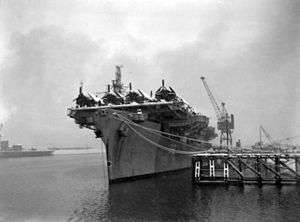HMS Ruler (D72)
 HMS Ruler in January 1945 | |
| History | |
|---|---|
| Name: | USS St. Joseph |
| Builder: | Seattle-Tacoma Shipbuilding Corporation |
| Laid down: | 25 March 1943 |
| Launched: | 21 August 1943 |
| Fate: | Transferred to Royal Navy |
| Name: | HMS Ruler |
| Commissioned: | 22 December 1943 |
| Decommissioned: | 29 January 1946 |
| Struck: | 20 March 1946 |
| Fate: | Scrapped, 1946 |
| General characteristics | |
| Class and type: |
|
| Displacement: | 15,390 tons |
| Length: | 492 ft (150 m) |
| Beam: | 108 ft 6 in (33.07 m) |
| Draught: | 26 ft (7.9 m) |
| Propulsion: | Steam turbines, 1 shaft, 8,500 shp (6.3 MW) |
| Speed: | 18 knots (33 km/h) |
| Complement: | 646 officers and men |
| Armament: |
|
| Aircraft carried: | 30 |
| Service record | |
| Part of: | British Pacific Fleet |
| Operations: | Battle of Okinawa |
HMS Ruler was a Ruler-class escort aircraft carrier of the British Royal Navy during World War II. She was built in the United States as the Bogue-class carrier St. Joseph (AVG/CVE/ACV-50) for Lend-Lease to the United Kingdom.
The name St. Joseph (making her the first United States Navy ship named for St. Joseph Bay, Florida) was assigned to MC hull 261, a converted C3-S-A1 cargo ship, on 23 August 1942. She was laid down on 25 March 1943 by the Seattle-Tacoma Shipbuilding Corporation of Tacoma, Washington. She was redesignated CVE-50 on 15 July, launched on 21 August 1943 and sponsored by Mrs. W.W. Smyth. The carrier was transferred to the UK on 22 December 1943 and commissioned the same day as HMS Ruler with the pennant number D72.
HMS Ruler served in the North Atlantic during 1944, protecting the vital flow of men and war materiel from the United States to Great Britain and to fighting fronts on the European continent. In early 1945, she transferred to the Pacific Theatre where she supported a raid on Truk and the campaign to take Okinawa.
After the war ended, Ruler returned to the United States at Norfolk, Virginia, on 28 January 1946. She was decommissioned from RN service on 29 January, and was accepted by the US Navy the same day. In excess of the Navy’s needs, she was slated for disposal and struck from the Navy Register on 20 March 1946. The ship was sold on 13 May and scrapped within the year.
Design and description
These ships were all larger and had a greater aircraft capacity than the preceding American built escort carriers. They were also all laid down as escort carriers and not converted merchant ships.[1] The ships had a complement of 646 men and an overall length of 492 feet 3 inches (150.0 m), a beam of 69 feet 6 inches (21.2 m) and a draught of 25 ft 6 in (7.8 m).[1] Propulsion was provided by two boilers which were connected to a steam turbine; it drove a shaft giving 9,350 brake horsepower (SHP), which could propel the ship at 16.5 knots (30.6 km/h; 19.0 mph).[2]
Aircraft facilities were a small combined bridge/flight control on the starboard side, two aircraft lifts 43 feet (13.1 m) by 34 feet (10.4 m), one aircraft catapult and nine arrestor wires.[1] Aircraft could be housed in the 260 feet (79.2 m) by 62 feet (18.9 m) hangar below the flight deck.[1] Ruler's armament comprised: two 4"/50, 5"/38 or 5"/51 Dual Purpose guns in single mounts, sixteen 40 mm Bofors anti-aircraft guns in twin mounts and twenty 20 mm Oerlikon anti-aircraft cannons in single mounts.[1] Each ship had a maximum aircraft capacity of twenty-four aircraft which could be a mixture of Grumman Martlets, Vought F4U Corsairs or Hawker Sea Hurricane fighter aircraft and Fairey Swordfish or Grumman Avenger anti-submarine torpedo bombers.[1]
Notes
References
- Cocker, Maurice (2008). Aircraft-Carrying Ships of the Royal Navy. Stroud, Gloucestershire: The History Press. ISBN 978-0-7524-4633-2.
- This article incorporates text from the public domain Dictionary of American Naval Fighting Ships.
External links
| Wikimedia Commons has media related to HMS Ruler (D72). |